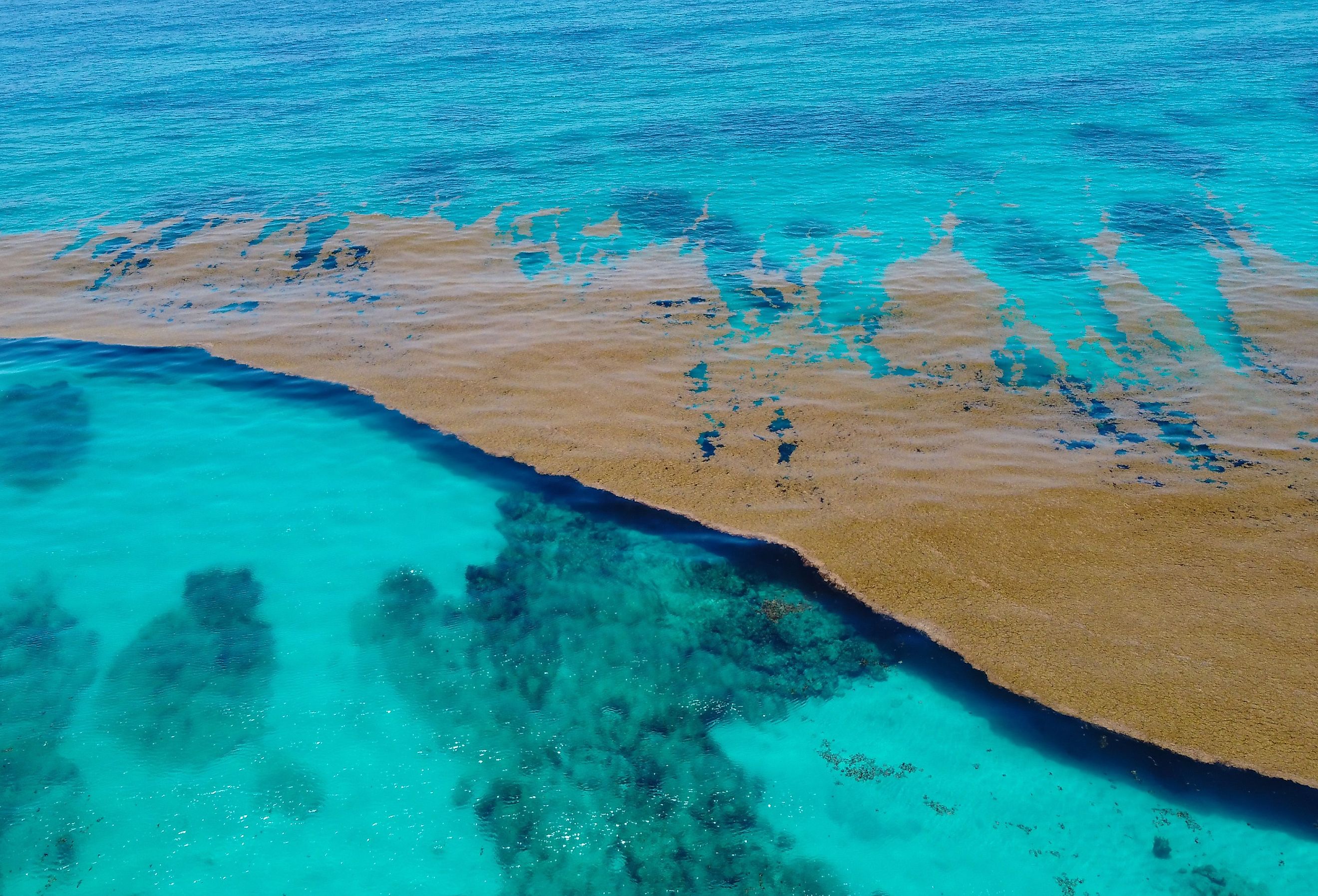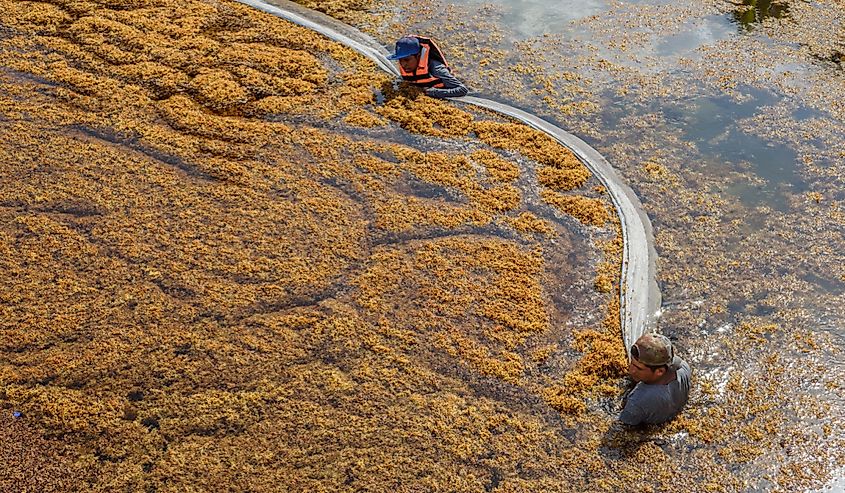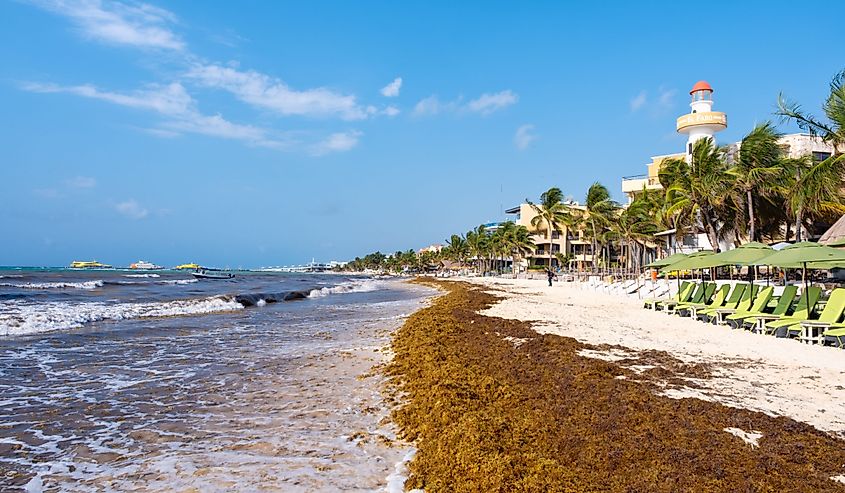
What is Sargassum?
While many people have traveled to Florida and Mexico, Sargassum is rarely discussed. Sargassum is a brown algae that naturally occurs in the ocean. The algae is a large brown seaweed that floats in large masses. While the seaweed is naturally occurring, problems arise when there is too much sargassum in the water. When sargassum rots ashore on a beach it releases gases that smell like rotten eggs which is often enough to ward away tourists. In the past few years, the Sargassum belt has had a big impact on Florida, and Mexico beaches.
What is a Sargassum?

Sargassum is a type of brown algae, found abundantly in the ocean. The large brown seaweed floats in big island masses, unattached from the ocean floor. Looking closely at the plant, the structure makes it easily identifiable. There are many leafy branches and round berry-like structures on the plant. However, the berry-like structures are not berries and are a structure called pneumatocysts. Pneumatocysts are gas-filled structures, filled mostly with oxygen. The pneumatocysts are buoyant and make brown algae float to the surface.
Floating clumps of sargassum are in the upper parts of the water column and can be very long, sometimes stretching for miles across the ocean. These clumps have always naturally occurred in the ocean. They help other organisms in the ecosystem, by providing a source of food and shelter. Sargassum also makes an ideal breeding ground for some animals, including fish, sea turtles, marine birds, crabs, and shrimp.
Some animals also depend on sargassum and spend their entire lives in the brown algae. For example, the sargassum fish, solely lives in brown algae. Other commercially important fish, such as mahi, jacks, and amberjacks also use sargassum as their breeding ground. Besides being an important source of shelter, sargassum serves as an important nutrient source. When the plant loses buoyancy and sinks to the ocean floor it becomes a source of carbon for deep-sea fish and invertebrates.
The Problem

While sargassum can be helpful to organisms in an ecosystem, the seaweed can also wreak havoc. When sargassum moves closer to the coast it becomes a problem. The brown algae can smother coral reefs and change the water's pH balance. When too much sargassum is ashore in an area, people around can usually notice because of the strong smell that resembles rotten eggs. This smell is enough to drive away tourists if the sites are still open. The economic impact of sargassum is that tourist sites often have to close down. This includes local marinas, which then constricts fishing yields. Sites with too much sargassum ashore have to close. This is because of the irritants the plant releases.
After 48 hours on land, sargassum will rot and release irritants such as hydrogen sulfide. This is hazardous to breathe in for people who have respiratory issues, such as asthma. These chemicals are also irritating to the skin. In some situations, sargassum toxicity has been a problem. People who each fish from affected areas are also known to develop Neurotoxic Shellfish poisoning, which can include gastrointestinal problems, tingling feelings in the mouth, and the reversal of hot and cold sensations.
Florida and Mexico Beaches

The problem with brown algae is not theoretical. Sargassum is causing problems on the beaches in Florida and Mexico. In 2011 scientists noticed a significant change in sargassum levels. Although the brown algae was previously present, the sporadic bodies were more sparse and sparsely found on local beaches. In 2011 there was a noticeable increase in sargassum size and density. The sargassum levels were so high that satellite images could detect their presence.
An article from NPR news reported that patches of sargassum make up a 5,500-mile-long, 10 million-ton belt. This belt circulates the Gulf of Mexico annually. The mass is almost double the width of the border of the United States. The belt starts near West Africa and moves through the Gulf of Mexico back into the Atlantic.
The size of the sargassum mass is inconsistent and fluctuates from month to month. Generally, the mass will be the biggest in the summer months. According to Brian Barnes, a researcher with the University of South Florida's College of Marine Science, the mass has dramatically increased in size. The low point in the fluctuation in the sargassum mass size is now what the highest point of the cycle was five or six years ago.
Causes of Increasing Sargassum Mass

The exact cause of the increase in sargassum mass is unknown. However, researchers have some guesses about what might be causing the problem. Researcher Brian Lapointe suspects how people are altering the nitrogen cycle may be causing the problem. Actions such as using more fertilizer, burning biomass, cutting down forests, and increasing wastewater, send more ammonium, nitrate, and phosphate down the major river systems. The increase in these nutrients goes into the ocean and feeds the sargassum masses.
Climate change is also believed to have contributed to the increase in sargassum blooms. The climate crisis causes stronger storms and flash flooding which can wash pollution into the ocean.
Researchers have found that over the last four decades, the ratio of nitrogen and phosphorous has gone up, simultaneously as the sargassum masses have increased. The trend is for nitrogen and phosphorus levels to continue to increase, along with sargassum blooms. This year, scientists predict, algal blooms will grow even more.
The Current Situation

Research from the University of South Florida's Optical Oceanography Lab tracks the sargassum blooms using NASA satellite imagery. The images show that the latest brown algae blooms have doubled every month from November to January. The ocean currents are moving the mass of blooms west, towards the beaches in the Gulf of Mexico, Florida Keys, and the eastern Caribbean.
Earlier in March 2023, 200 tons of sargassum washed ashore on beaches in the Yucatán Peninsula. This may sound like a lot but is a small amount relative to the 26,000 tons thought to be floating in the Caribbean. Local authorities responded by coming up with a clean-up operation. The resorts were proactive by hiring large cleanup teams to remove the sargassum each morning. Beach cleanups happened before tourists began their day at the beach, and continued throughout the day.
The Yucatán Peninsula was not the only beach affected by the sargassum blooms. The University of South Florida predicted the Florida Keys may start to see small amounts of sargassum blooms in March. People started seeing sargassum blooms, on beaches, as early as mid-February. The algae has increased in several other southwest Florida counties, at higher than normal rates. This has led to restrictions on beach access.
Problem-Solving

To deal with the increase in sargassum blooms, local authorities sometimes use heavy machinery, such as tractors, and dump trucks to clear the blooms from beaches. Last year, Barbados had 1,600 dump trucks remove brown algae from their beaches daily. There are concerns over this method of removal since it can lead to other environmental problems, such as destroying sea turtle nests and erosion.
However, removal is essential considering the potential consequences. Last year the US Virgin Islands saw what could happen when sargassum blooms are not properly dealt with. The islands declared a state of emergency when the high amounts of algae blooms negatively impacted water-production capabilities on St. Croix.
Some companies are attempting to create inventions to deal with the sargassum problem. For example, people have attempted to turn the brown algae into food, fertilizer, and construction material. However, the safest option for dealing with sargassum is still considered prevention.
Conclusion
Accumulating sargassum on beaches hurts tourism, making dealing with the problem important, for both environmental and economic reasons. While people disagree on how to deal with the sargassum problem, researchers seem to agree that the algae problem is here to stay. To mitigate risks from sargassum, look into the beaches you are visiting. The brown algae is the most abundant in the summer. Check online to see if there are any warnings from local authorities and plan your travels accordingly.











